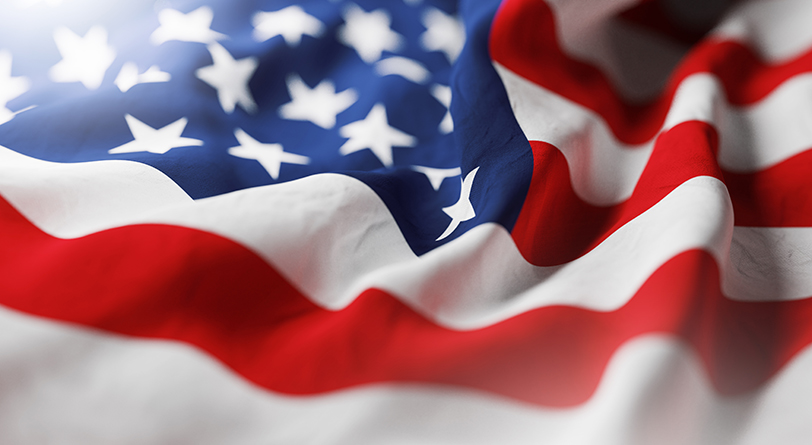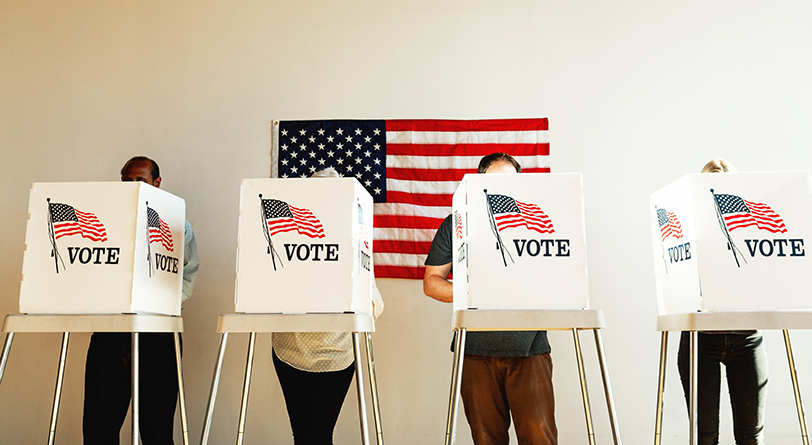FlexPAC™ Gears up for Elections
FPA’s Political Action Committee Plans for the Future

The flexible packaging industry took a significant step into the political arena in 2024 with the creation of its first political action committee (PAC). Dubbed FlexPAC™ and formed by the Flexible Packaging Association (FPA), the committee aims to help the industry reach its policy goals by supporting candidates in federal elections.
The PAC is funded by voluntary personal contributions of authorized FPA members and will back candidates who understand issues facing the industry such as extended producer responsibility (EPR) and product labeling.
Early contributors include Kevin Keneally, president and CEO of PPC Flex, which is based in Buffalo Grove, Illinois.
“I support FlexPAC™ because the legislative and regulatory headwinds facing our industry need a strong, cohesive advocacy strategy,” Keneally says. “FlexPAC™ is a critical tool and an important industry resource to elect pro-business, pro-packaging candidates to federal office who will stand with us on the issues.”
The Origins
FPA unveiled FlexPAC™ in March during its annual meeting in Tucson, Arizona, at an event headlined by George Khalaf, president of political research firm Data Orbital and managing partner of The Resolute Group. He offered insights into the 2024 election season.
The new PAC is being advised by Kelly Knowles, a political adviser and consultant to FPA with more than two decades of experience in politics. She credits Alison Keane, FPA’s former president and CEO, with grasping the benefits of establishing a PAC for the flexible packaging industry.
“Alison understood the deep connection in advocacy between influencing legislation and regulation, but then also electing the right people to office,” Knowles says.
“A very effective way to do that is by forming a political action committee representing the industry’s collective voice under the umbrella of the trade association.”
PACs help organizations meet and educate candidates seeking office while supporting their electoral efforts, Knowles says. FlexPAC™ does not favor one political party over another. Rather, it seeks to become a bipartisan player, cultivating relationships with candidates who value the flexible packaging industry and will support FPA efforts in Washington, D.C., and state capitals.
“What we care about is where members of Congress and candidates stand on the issues that are important to FPA members. Are they willing to carry water for us on key legislation? And those folks can be Democrats, independents, and Republicans,” Knowles says.
Senior leaders in the flexible packaging industry quickly rallied around FlexPAC™, and others in the industry are coming on board, Knowles says. She adds that industry figures are acutely aware of the policy and regulatory challenges facing the flexible packaging sector.
A presidential election year is an effective time to launch a PAC, since the intense campaigning often translates to greater political engagement, she says, adding that flexible packaging leaders already are engaged.
“FPA has a politically astute membership, and they become more so with each passing year,” Knowles says.
“I think it’s a great achievement for FPA that they’ve launched this PAC. It’s a critical tool that is going to make a difference in sharpening their advocacy strategy and achieving their policy goals.”
“FPA has a politically astute membership, and they become more so with each passing year. I think it’s a great achievement for FPA that they’ve launched this PAC. It’s a critical tool that is going to make a difference in sharpening their advocacy strategy and achieving their policy goals.”
Kelly Knowles, FPA’s PAC adviser
The History
PACs have been around for more than 80 years. The Congress of Industrial Organizations, a forerunner to the AFL-CIO, created the first PAC in 1943 to back the reelection of President Franklin D. Roosevelt. The move was precipitated by a 1943 law barring union members from contributing directly to candidates for federal office. The PAC collected contributions from union members and directed them to political campaigns, setting a template for other PACs to follow.
PACs were largely unregulated for their first 25 years of operation. But that changed in 1971 with the passage of the Federal Election Campaign Act, which was enacted in response to concerns about election-related financial abuses following the Watergate scandal.
The law set several conditions on PACs, ranging from a cap on contributions to requirements for public disclosure to limits on how much they can donate to campaigns. The limit is $5,000 per candidate per election. The law also created the Federal Election Commission (FEC) to oversee campaign finance laws. The new standards led to wider adoption of the PAC model, and today, there are thousands representing a variety of interests.
Additional reforms were enacted in the early 21st century under what is known as the McCain-Feingold Act. The 2002 law targeted so-called soft money raised by political parties for “party-building” activities rather than for specific candidates.
Another change came to PACs in the wake of two U.S. Supreme Court rulings in 2010. The rulings paved the way for what are known as super PACs, organizations that have no limits on what they can raise and spend on political advertising as long as they do not coordinate their efforts with an individual candidate’s political campaign. Super PACs may also accept corporate contributions. Traditional federal PACs such as FlexPAC™ may not accept corporate contributions. FlexPAC™ may only accept personal contributions from executives employed by FPA member companies.
As a traditional PAC, FlexPAC™ also must disclose every dollar raised and every dollar contributed to FEC, making it public information. Traditional PACs are one of the most transparent forms of political engagement that exist today.
The Issues
Flexible packaging has long been in the political spotlight, primarily due to concerns about plastic waste and recycling. Over the next few years, the chief federal issues for the industry are likely to revolve around labeling for product recyclability and EPR.
State lawmakers have been drafting laws on both issues, prompting concern that a patchwork of standards would complicate compliance.
As of 2023, five states adopted EPR rules for packaging, shifting the financial responsibility for recycling onto packaging producers. They are California, Colorado, Maine, Minnesota, and Oregon, according to the Product Stewardship Institute.
None have been fully implemented, says John Richard, FPA’s director of government relations. But they will be soon, leading to potential conflicts between state rules and eventual calls for a federal response, says Richard, who expects the discussion to start with roundtables and policy discussions.
“It’s important to stay engaged with the conversation and to inform lawmakers as the pressure builds,” he says.
Changes to product labeling are being driven by growing discontent with the traditional chasing arrow label, conceived in the 1970s for use on recyclable cardboard products. California passed a law in 2021 aiming to tighten standards around the use of labels indicating whether a package is recyclable.
While the law has been on the books for over three years, regulators are still fine-tuning the fairly complex details. They rely, in part, on assessing what exactly is recyclable in what places. Nonetheless, federal legislation is already in the works that would preempt the California law and forestall conflicts with regulations in other states. Some states, for example, mandate the use of the chasing arrows.
Efforts to reduce food waste represent another issue touching on flexible packaging. The Biden administration unveiled a national strategy for curbing waste in June 2024. Included in the strategy are several recommendations for researching new approaches to packaging and recycling, including closer looks at packaging from bio-based materials and renewably sourced polymers.

What’s Next
As a new organization, FlexPAC™ did not make any contributions during the most recent election cycles. Rather, leaders have been focused on raising funds for campaigns in 2026 and 2028. As of September 2024, the PAC had brought in about $45,000 toward its goal of $50,000, Knowles says.
The PAC will begin the process of vetting candidates to support, whether in primary or general elections. PACs can donate to candidates during both types of elections, and FlexPAC™ plans to focus initially on congressional races, Knowles says.
As a bipartisan organization, FlexPAC™ will assess candidates’ voting records, but that is not the only criteria. PAC leaders also will assess whether FPA member facilities are located in a candidate’s state or district.
“That’s often a big part of the decision as we want to make sure we are cultivating supportive relationships with members of Congress and candidates who represent our key facilities,” Knowles says.
In addition, PAC leaders will evaluate candidates based on their committee assignments and leadership. Do they serve, for instance, on panels that handle legislation related to packaging or environmental regulation?
The PAC also can take recommendations from its contributors, who may be aware of candidates running for federal office for the first time, Knowles says.
“A lot of the valuable intelligence we receive is from members who identify promising candidates in their districts. That certainly carries a lot of weight,” she says.
People may disengage from politics this year following the sharp-elbowed presidential campaign. Nonetheless, leaders in the flexible packaging industry are enthusiastic about the FPA’s new venture.
“FlexPAC™ will help enable the flexible packaging industry and the FPA team to effectively educate, build relationships, and support members of Congress and candidates who work to foster free markets and economic growth and stand with us on key policy priorities,” says William Jackson, Ph.D., FPA chair and chief technology officer at Amcor Global Flexible Packaging for Amcor Flexibles.
For more information about FlexPAC™ activities, contact Knowles at kknowles@flexpack.org or learn about the PAC at www.flexpac.org.
Joel Berg is a freelance writer and editor based in York, Pennsylvania.


